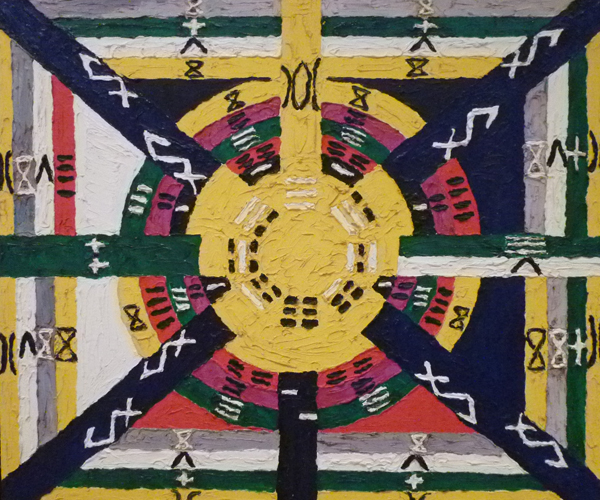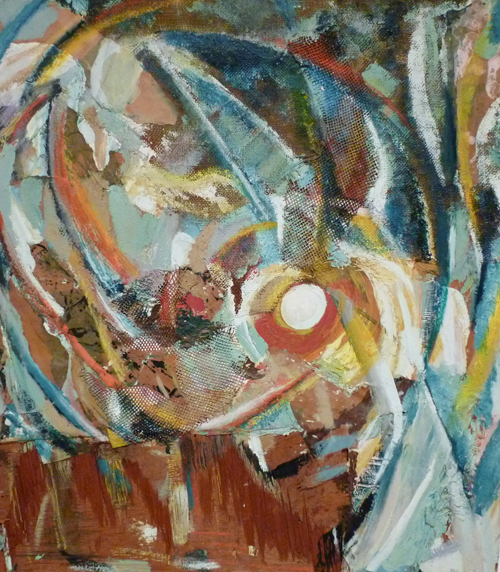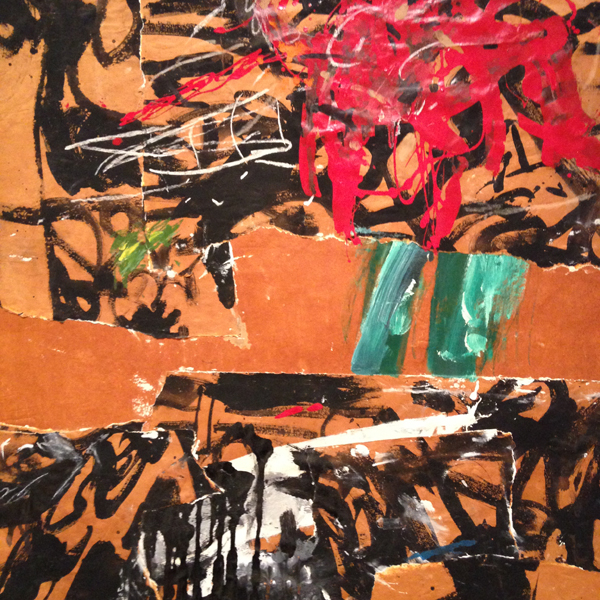Inventing Downtown
Ron Morosan
February 2017
 Close-up from Hale Woodruff, Blue Intrusion, 1958, image courtesy of Arteidolia
Close-up from Hale Woodruff, Blue Intrusion, 1958, image courtesy of Arteidolia
INVENTING DOWNTOWN
Artist-Run Galleries in New York City, 1952-1965
Every once in a while an art exhibition comes along which asks a question.
Such is the case with Inventing Downtown. The question being asked is: “What really happened with artist-run galleries during the years 1952 to 1965?” While there have been other exhibitions that explored this period and have labelled it the Tenth Street Scene, this exhibition is different. Curator Melissa Rachleff, the Clinical Associate Professor of Art Management, Visual Arts Administration MA Program at New York University, has taken an investigative approach to curating and assembled an exhibition that is almost an art forensics of the period. Hung in semi-salon style, an enormous number of paintings, drawings, and sculptures have been included. We are invited to examine the different artist-run galleries, where we find well known artists like Jim Dine, Allan Kaprow, and Yayoi Kusama hanging side by side with less well known or almost unknown artists like Jean Follett, Gloria Graves, and Emilio Cruz.
Alex Katz, Sidney Geist, Mary Frank, Philip Pearlstein, Peal Fine, left to right, image courtesy of the author
As we go through the exhibition and read the excellent catalogue, we see several answers to the question of what happened to artists and the fourteen galleries they initiated and are represented in this show. First, we observe a very clear sense of a distinct community emerging from this group. Claes Oldenburg’s cut-out signs and figures look very comfortable and very urban among work by assemblage artists like Jean Jacques Lebel and Red Grooms; Alex Katz is very close in visual sensibility to Marcia Marcus. There is a certain urban bohemian spirit to all the work that seems to express very strongly the feeling of the late fifties and early 60’s, when change and challenge were palpable. Also at this time Abstract Expressionism was recognized as the heroic American style: De Kooning and Pollock were being celebrated and bought by uptown collectors. The influence of this success is evident in the work of some of the artists in the exhibition, most notably in the work of Angelo Ippolito at the Tanager Gallery and Hale Woodruff of the Spiral Group, as well as several others.
Of the fourteen galleries represented, we see a selection of the ideas and sensibilities artists were pursuing. On the political side we see work in the March Group section by Boris Lurie, Stanley Fisher, and Jean Jacques Lebel, a group that advocated an almost anarchist vision of anti-capitalist sensibility and social rebellion against the consumer culture which they saw developing in Madison Avenue packaged lifestyles and the corporatization of the planet earth.
In the City Gallery we encounter work by Jay Milder, Emilio Cruz, and Red Grooms that deals with a pursuit of social compatibility and a hopeful trust that art will be a great equalizer and energizer of peace and equanimity. An intimate humanism comes through in this work, particularly in the drawing “Dancers”, 1960, by Emilio Cruz.
 Alfred Jensen, Heaven and Sky, 1960, image courtesy of the author
Alfred Jensen, Heaven and Sky, 1960, image courtesy of the author
From the Tanager, the Brata, and the Hanza Galleries we see paintings that are experimental, fresh, and filled with a vitality that all members share. An early Alfred Jensen, “Heaven and Earth” from 1960 indicates the early date from which Jensen began his obsessive mystical calendaring of color and line as energy fields. At the Spiral Group, a little known group of African-American artists, we see the early beginning of Romare Bearden’s collage style, and an outstanding painting from 1962 “Sun Above City” by James Yeargans, one of many works by virtually forgotten artists in this show.A second question emerges: What happened to all the good artists that did not become brand names? As in all commercial systems in culture, there are forces at work that cause one element or group to come out at the top of the heap, so to speak. This has little to do with the quality of work. But it certainly has a lot to do with what was promoted and who promoted it.
 James Yeargans, Sun Above City, 1962, image courtesy of the author
James Yeargans, Sun Above City, 1962, image courtesy of the author
Amidst the tight interactivity of the artist-run galleries a couple of people emerge who seemed to come out of nowhere. They are Richard Bellamy and Ivan Karp. Both entered the art scene at this time as want-to-be writers or poets. Karp had written a bit of art criticism and Bellamy was a lover of poetry. As it happened, the artist galleries needed gallery sitters. Both Bellamy and Karp fulfilled this role at the Hansa. Later, Bellamy would become director of the Green Gallery uptown, and Karp would become the colleague of Leo Castelli at the Leo Castelli Gallery.
As we examine more of the evidence presented in Inventing Downtown we start to see how this exhibition shows the missing link in the development of what has become known as American Art of our time, how the triumph of Abstract Expressionism is forced to give way to the explosion of Pop Art, and also the cool intellectual narrative of Minimal art. Both of these later developments were promoted by Richard Bellamy when he was director of the Green Gallery. Inventing Downtown shows us how Bellamy recognized that he was in the middle of a real cultural phenomena, and he took the ball and ran with it. Ivan Karp realized this too; when he worked with Leo Castelli they assembled the roster of artists who would become the foundation of Pop Art. By the mid-sixties, the Castelli Gallery represented Rosenquist, Oldenburg, Warhol, Lichtenstein, and Wesselmann.
Martha Edelheit, Frabjous Day, 1959, image courtesy of the author
While Inventing Downtown does not represent all the important galleries that existed during this time, galleries like the Camino, Area, and Phoenix, it does an excellent job of recreating the feeling and sensibilities of that time. We are prompted to speculate on what the art of the past fifty years might have looked like if artists of the social figurative group or the political group had been promoted. But, speculation is just imagination.
The success of Pop Art proved that the USA is a consumer culture and the art that was encouraged had to reflect that. This is no surprise. As a commercial consumer culture we follow brands and trends. Pop Art celebrated this.
In the larger sense the cult of celebrity and the trend of “winner take all” success came to define the USA. Popular culture is not poetic or intellectual. Therefore, the poet artists and intellectual artists of Inventing Downtown would find themselves having a harder time securing patrons and representation in the the largest museums.
Inventing Downtown demonstrates how the college or university art gallery can produce exhibitions that can be as important as those produced by mega-institutions like the Whitney or the Guggenheim. Melissa Rachleff spent seven years researching the history of this period, and the catalogue shows her efforts. For anyone interested in artist-run galleries and this period of American art this exhibition is a must-see.
 Close-up from Allan Kaprow, Blue Blue Blue, 1956, image courtesy of Arteidolia
Close-up from Allan Kaprow, Blue Blue Blue, 1956, image courtesy of Arteidolia
INVENTING DOWNTOWN
Artist-Run Galleries in New York City, 1952-1965
Grey Art Gallery
New York University
100 Washington Square East
January 10 – April 1, 2017

Well written article, good photos of the work
Thanks for this clear and insightful discussion of the exhibit. Morosan gets to the heart of explaining how Pop Art prevailed over other political and social concerns of the time: “The success of Pop Art proved that the USA is a consumer culture and the art that was encouraged had to reflect that. This is no surprise. As a commercial consumer culture we follow brands and trends.”